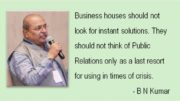The message is ‘king’ in Public Relations. And, PR messaging depends on clear communication. Powerful messaging refines your communication strategy.
Communicating successfully to your customers may prove to be a tough job; it can be a tricky deal to achieve in the real world. So, establishing key messages for your business can go a long way.
Any good PR messaging strategy involves conveying to the public – both your core company values and the benefits you provide.
Why do you need a message strategy?
With a strong set of core messages, your company will have consistent, effective messaging throughout your marketing and communications efforts. You can use your core messages for crafting many documents, including your company backgrounder, brochures, press releases and boiler plates, mission and vision statements, presentations and other materials.
Putting everyone on the same page is another benefit of a message strategy, as far as understanding what your company is, what your value proposition is, and how you communicate it to your target group.
So, whether you do it on the portal, press releases, blogs or a mission statement – here are some tips:
- Craft key messages effectively
Crafting workable key messages is crucial. It is a fine art, for messages should be constructed with the aim to keep it simple but at the same time, see to it that there’s enough punch packed in – to provoke interest. When creating key messages, we must keep in mind some factors: information must need a purpose (to generate further investigation by your audience), it should be believable, brief, which is crucial (as attention spans are limited); it should be distinctive, attention-grabbing, the language used should be simple and positive – to make it accessible to the broadest possible audience. Industry experts, journalists and the public should get the plot when reading key messages. Key messages are first impressions, which should be positive and long-lasting.
- Ask productive questions
While writing an article or email reply, it’s good to be specific in your communications. If you truly want to stand out, you need to ask yourself some of the following questions regarding your messaging. What problem will this solve for my customer? How will this change their perspective from this day forward? Why would anyone want to read this message? What will be the most memorable thing about this message? And perhaps the most important of all: Why am I writing this? If your answers to these are strong and clear, your PR messaging is on the right track!
- Be clear and concise
Communication that avoids flowery language should always be your goal. Write with precision, edit (at the content creation stage), delete unnecessary words and use active verbs to make your sentences stronger.
When communicating verbally, think about your communication techniques. It’s tempting to throw in an anecdote or repeat something you said earlier, but is it really necessary?
- Avoid jargon
Good PR messaging uses words and ideas that the average customer understands. Industry-specific jargon leads to misinterpretations and also to loss of customers.
Keep an eye out for some jargon like – alignment, champion, asset, impact, leverage, analytics, ROI, touch base, synergies etc. Eliminating these, will create communication that everyone can understand.
- Memorable messages only
There’s no point in communicating if there is no recall. Creating memorable messages is a challenge, but it’s easier if you follow the “C”s of communication. Make sure it is comprehensive so that your audience understands the main points through repetition, concision, and simplicity. Connection ensures there is value for the audience or they won’t pay attention. There should be credibility – the person conveying the message must be believable. And, the message must be contagious so that it can be easily spread by your audience. The more people who read it, the more people will begin to accept your message and connect with your business.
And, lastly, messaging should be consistent. One of the most important reasons for using key messages is consistency. The messages should remain the same across various platforms, that are at your disposal. Consistency works on two levels: it sets you apart as reliable and it also helps to fix these messages in the minds of the audience.
A good PR messaging strategy will guide all your communications efforts to success!










Be the first to comment on "Power messaging refines communications strategy"